-
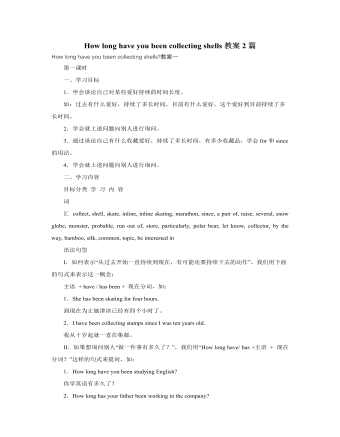
人教版新目标初中英语八年级下册How long have you been collecting shells教案2篇
Step Ⅱ Show the new words on the screen and teach the new words. Read the new words to students and ask them to repeat.Step Ⅲ 3aThis activity introduces new vocabulary and provides reading practice using the target language.In this activity first look at the four pictures.T: What can you see in the pictures?Ss: Four snow globes.T: Right. There are four snow globes in the pictures. And what are they?Ss: They are a monster, two polar bears, two penguins and a birthday cake.Write these words on the blackboard: snow globe; monster; polar bear; penguin and birthday cake. Read them to the class and ask students to repeat each one. Make sure students understand each word.Use a computer to show the E-mail message on the screen and read the message to students.Get students to read the e-mail on their own, and then draw lines connecting each snow globe and its description.Correct the answers.AnswersA line should connect each snow globe picture with the words that describe it in the letter.Step Ⅳ 3bThis activity provides writing practice using the target language.First review Activity 2a on Page 47.Then ask students to complete the message according to Activity 2a.Some partial sentences are given to students. Write about one person's collection.When students work, walk around the room checking the progress and offering help as needed.When they finish, ask some students to read their messages to the class.
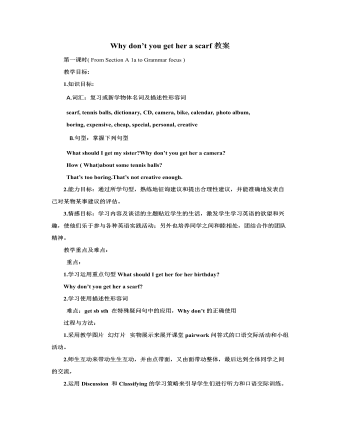
人教版新目标初中英语八年级下册Why don’t you get her a scarf教案
教师带领学生复习有关描述宠物的词汇,采用教师提问学生回答的方进行。如:T:What animals do you think would be good pets?What animals do you think would be bad pets?What do you think are good animals for a six-year-old child?然后学生进行 pairwork 练习。Task two: 师生互动,学习探究 1、播放3a部分的录音,引导学生一边听录音,一边跟读。2、通过听录音学生回答以下问题:Why do you think pot-bellied pigs are popular?What are the advantages and disadvantages of keeping such a pet?教师对学生的回答进行及时点评。3.学习范文,学习重点短语,为下步的模仿写作提供语言素材。T :1. )Have you ever kept a pig as a pet?Do you like pigs? St.:No.…Why don’t you like to keep a pig? St: No.They’re too dirty and lazy(Do you know in some foreign countries like Hollyland, Australia,pigs are the most popular pet.there’s a kind of pig.(图)it has an interesting name? it ‘s called a pot-bellied pig.) Now,let’s learn an article about this kind of interesting pet.2.)play the tapeSt.:Listen and repeat3.)show some Qs on computer(本子St.: read silently,then answerthe Qs(本子)4.)Ask ss. Close book and retell this passage.(what is a pot-bellied pig? Is it a good or bad pet? ) St.: retell it to each other“A pot –bellied pig is a popular pet now…”5.read the article together.St.:.practice reading
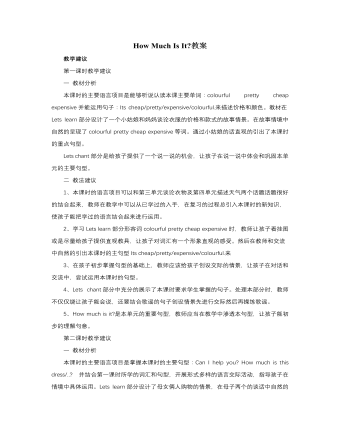
人教版新课标PEP小学英语四年级下册How Much Is It教案
一 教材分析本课时的主要语言项目是能够听说认读本课主要单词:colourful pretty cheap expensive并能运用句子:Its cheap/pretty/expensive/colourful.来描述价格和颜色。教材在Lets learn部分设计了一个小姑娘和妈妈谈论衣服的价格和款式的故事情景。在故事情境中自然的呈现了colourful pretty cheap expensive等词。通过小姑娘的话直观的引出了本课时的重点句型。Lets chant部分是给孩子提供了一个说一说的机会,让孩子在说一说中体会和巩固本单元的主要句型。二 教法建议1、本课时的语言项目可以和第三单元谈论衣物及第四单元描述天气两个话题话题很好的结合起来,教师在教学中可以从已学过的入手,在复习的过程总引入本课时的新知识,使孩子能把学过的语言结合起来进行运用。 2、学习Lets learn部分形容词colourful pretty cheap expensive时,教师让孩子看挂图或是尽量给孩子提供直观教具,让孩子对词汇有一个形象直观的感受。然后在教师和交流中自然的引出本课时的主句型Its cheap/pretty/expensive/colourful.来
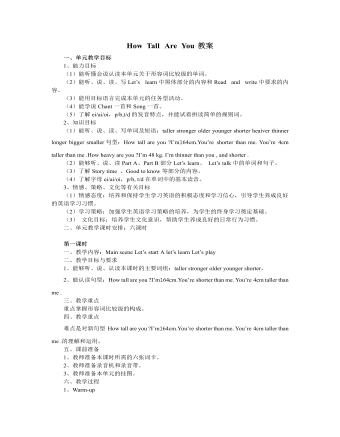
人教版新课标PEP小学英语六年级下册How Tall Are You教案
(1)呈现猴子图片,初步接触知识.教师在发指令时,加入 Touch your tail.当学生觉得茫然时,老师趁机出示课件(一只猴子)Look,We have no tails,but the monkey has.Look at the monkey,How long is the tail?在课件上呈现数据38cm.学生回答:Its tail is38cm long.根据教材内容教师提问:How tall is the monkey?学生:It’s 40cm tall.老师自己引出only一词,注意这个词的发音.多媒体再出示两只猴子的图片,一只黄色,一只棕色,让学生加以比较.教师问:Which monkey do you like?The yellow one or the brown one?【设计思路】 学生在回答这些问题时,也同时在复习前两课时所学内容,起到知识循环的作用.(2)猜一猜游戏:它们有多高?让学生猜一猜这两只猴子的身高.注意提示学生用上I think….这一句型,表示自己的猜测.在这里也可安排一个竞赛,看谁能猜中正确数据,教师让一些学生猜后出示数据.【设计思路】 学生对有悬念的东西都特别感兴趣,在此不仅练习了两位数的读法,又满足了学生的好胜心理.

人教版新课标PEP小学英语五年级下册Recycle1教案(内容详细)
学生搜集中外重要节日及部分中外名人的生日所在的月份。教师准备相关节日及部分中外名人的图片或音像资料片。教师课前准备Let’s find out2的配图画好春、夏、秋、冬四个方框。录音:Listen and number。教学过程:Warm up (热身)活动一复习单词教学参考时间:3分钟(1)教师播放Let’s chant部分的歌谣,学生听一遍后跟唱。(2)出示带有各个月份特征的单词卡片。学生看图说出单词,并一起拼读其缩写形式。帮助学生在有节奏的说唱中巩固记忆单词,为在后面活动中学生能够熟练应用作铺垫。活动二 复习句子教学参考时间:5分钟(1)师生同唱Let’s chant部分歌谣“When Is Your Birthday?”。(2)教师引导学生看歌谣下面的翻滚过山车的动画,师生进行问答,如:When is the rabbit’s birthday? It’s in May. 等。教师示范后请学生进行Pair work,也可以展开竞赛的形式进行“连锁问答”。巩固有关生日问答的语句,为Let’s find out1的活动做准备。
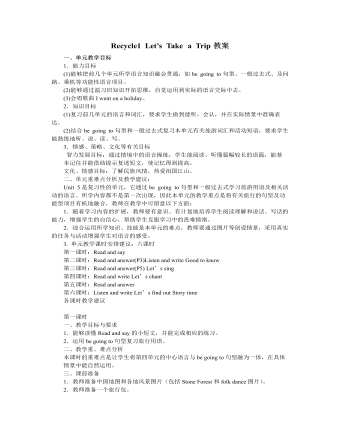
人教版新课标PEP小学英语六年级下册Recycle1 Let’s Take a Trip教案
4.巩固和扩展(Consolidation and extension) (1) 做本单元活动手册配套练习。 (2) 翻卡片说单词。学生两人一组,把单词卡片反面朝上放在桌子上,然后同时翻开两张单词卡(如:going, holiday),就马上组织成一句话(如:Where are you going on the holiday?/ I’m going to Kunming this holiday.),说得快又正确者为胜。 (3) 教师播放C部分Story time的录音或VCD,帮助学生理解故事内容。学生再听一遍录音,跟读故事里的句子,教师指导学生发音。 (4) Bright eyes. 在黑板上张贴Let’s find out的8幅图片,Mike, Zhang Peng, Sarah, Kathy等4个人物图片分别放在8幅图片上,如:Mike ---take pictures---buy presents。学生仔细观察后,请学生闭上眼睛,教师就趁学生闭眼之际交换人物位置(如把Mike放到eat noodles),然后请学生张开眼睛回答:What did Mike do just now ? 引导学生回答: Mike took pictures and bought presents. 教学参考资料库 1.文化背景介绍: 机场标志: Airport 飞机场 Airport lounges 机场休息室Airports shuttle 机场班车 Arrivals 进港Assistance 问讯处Check in area (zone) 办理登机区Departure airport 离港时间Departure times on reverse 返航时间 Welcome aboard 欢迎登机
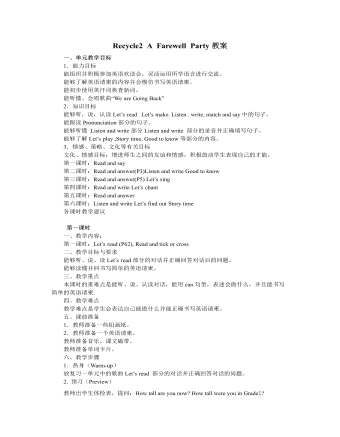
人教版新课标PEP小学英语六年级下册Recycle2 A Farewell Party教案
3. 新课呈现(Presentation) Let’s make (1)教师说:Miss White is making a book about her students. So she can remember them well.Who are the students? 请学生独立或分小组朗读四段短文,解释学生不理解的句子,然后说:There are four pictures below. Would you like to help Miss/White glue the pictures? 教师知道学生完成图文搭配的练习。 (2)教师发给每名学生一张铅画纸,说:Now please draw a picture of your best classmate. Then describe him or her.学生画一副最要好的同学的肖像,并在傍边配上对该同学的英语介绍。 学生上讲台介绍自己最要好的同学,请其他学生猜是谁,看谁说的生动又贴切,教师给予评价时注意强调第三人称单数形式的使用。 Story time 教师向学生展示Story time部分的教学挂图,指着最后一副图中的Zoom 和 Zip说 Look at the picture. Zoom and Zip are sad. They are saying goodbye to each other. Now let’s see What happened. 学生同桌之间合作阅读或是,然后教师提出问题Where is Zip going? Is this good news for zoom ? What grade is Zip going to be in? 教师放录音,学生录音跟读故事,然后再分角色朗读.
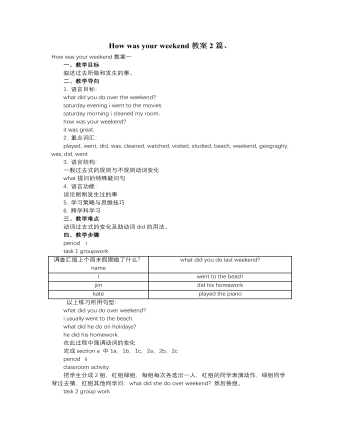
人教版新目标初中英语七年级下册How was your weekend教案2篇
Teaching Goal:1. General aims:Talk about recent past events2. Particular aims:A. Language Focus.Talk about recent past events and think of the past events.B. Language goalsHow was….?It was …What did …do over the weekend?C. Language structures:(1). How was your weekend? I was great. Pay attention to no form.(2). What did you do over the weekend? I played soccer. We went to the beach.D. Useful words and phrases:Words: was, did, went, beach, over, project, test, wasn’t, false, number, geography, spend, week, most, mixture, their, had, little, cook, read, saw, change, everyone, sit, sat, no, anythingPhrases: did one’s homework, played soccer, cleaned my room, went to the beach, played tennis, went to the movies, on Saturday morning, over the weekend, cook … for, what about, do some reading, have a party, talk show, go shoppingE. Grammar language:Present simple past tenseRegular and irregular verbsF. Learning strategies:Tour and holidaysG. Interdiscipinary:H. Emotion and manner:Teaching time: 5 periodsTeaching procedures:Period One教学步骤、时间 教师活动 学生活动 媒体应用Step 1Free talk 3’ Ask some questions like:Who’s on duty today?What’s the weather like? Answer and talk about something.让同学们回答下列问题1. Do you like weekend? (Let some students answer)It takes them three minutes to talk about the question.2. Why do you like weekend? (let the students answer) Most of the students like the weekend此时教师用汉语问:“在周末期间问你干了什么?这句话用英语这么回答?Let the students guess.At last the teacher give them right answer3. What did you do over the weekend?(板书、学习)
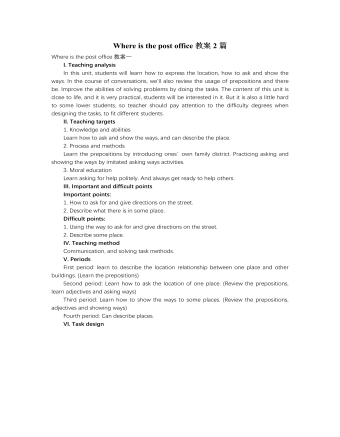
人教版新目标初中英语七年级下册Where is the post office教案2篇
Period 2 (3a----Section B 2c)Preview(Pre-task): Key points: What laAdd another information about their pen pals----their language on the cardnguage does she/he speak?She/He speaks....Does she/he have any brothers and sisters? Does she/he speak English?Preview(Pre-task): Add another information about their pen pals----their language on the cardKey points: What language does she/he speak?She/He speaks....Does she/he have any brothers and sisters? Does she/he speak English?Step 1 Revision1.Revisionand dictation of the new words 2.Revise the drills they learned yesterday.(by pairwork and grammar exercise)Step 2 Leading-inT has a conversation with one student. The conversation is following:---Do you have a pen pal?---Yes, I do.---What's your pen pal's name? ---His/Her name is....---Where is your pen pal from? ---He/She is from...---Where does he/she live? ---He/She lives in....---What language does he/she speak?He/She speaks...Write the new words on the Bb. They are following: EnglishChineseJapaneseFrenchStep 3 LearnLearn the new words with the whole class.Finish 3a with the students3b Pairwork T still does an example with one student Then the Ss practise in pairs. The example is following:--Curry Muray is my pen pal. He is from the United States.---What language does he speak?
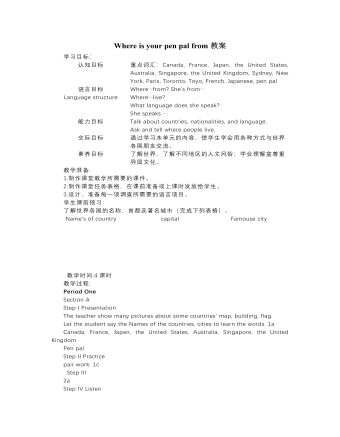
人教版新目标初中英语七年级下册Where is your pen pal from教案
2.1Match the country with the language.Step II Reading3a? let the students read the letter fast and answer the questions.? Let the students ask more questions about the letter as possible as the can.Step III Writing3b.Step IV. Pairwork2cStep V Listening2a, 2bStep V. HomeworkExercises book(1) P3Exercises book (2) P3Period FourStep I . Dictate the words and sentences in Unit1.Step II. Self-checkStep III. Check the answers for Exercises book in the unit.Step IV. Home workRevise and preparation for unit 2.教学反思:通过本单元的学习,学生基本可以谈论人们的国籍,居住城市及其所说的语言,通过书信方式去介绍自己并寻找笔友。但在涉及到国外的一些城市时,学生对这方面的知识相对欠缺,能介绍的城市并不多,也反应出学生课前预习不充分,这跟学生学习条件也有关,大多数学生无法通过网络获取所需信息。因此,在以后的教学中要多指导学生通过计算机网络获取信息,拓宽知识面。
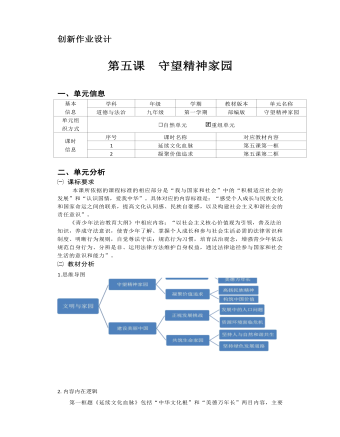
九年级上册道德与法治守望精神家园2作业设计
2. 内容内在逻辑第一框题《延续文化血脉》包括“中华文化根”和“美德万年长”两目内容,主要阐述了中华优秀传统文化是中华民族的根,中华传统美德是中华文化的精髓。第一 目侧 重从中华文化的丰富与发展角度,讲述中华民族在五千多年文明发展中孕育、创造的源 远流长、博大精深的中华文化,重点落在“中国特色社会主义文化积淀着中华民族最深 层的精神追求,代表着中华民族独特的精神标识,为中华民族伟大复兴提供精神动力”, 我们要坚定文化自信。第二目侧重从代代传承的中华美德角度,阐释中华传统美德的丰 富内涵和重要价值,重点落在“中华传统美德是中华文化的精髓,蕴含着丰富的道德资 源,是建设富强民主文明和谐美丽的社会主义现代化强国的精神力量”。第二框《凝聚价值追求》学生在前一框题学习了中华文化的作用与发展,增强了文 化自信心;学习了中华美德的内涵及影响,明白了美德的力量在践行。
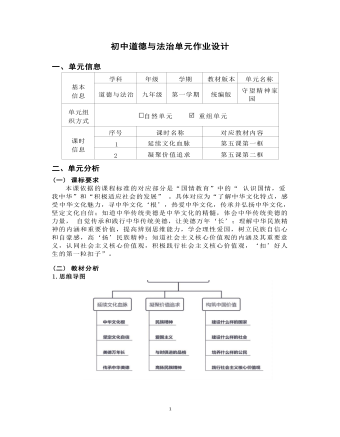
九年级上册道德与法治守望精神家园3作业设计
4. 央视出品,必属精品。中央电视台大型文化节目《典籍里的中国》,聚焦优 秀中华文化典籍,通过时空对话的创新形式,以“戏剧+影视化”的表现方法, 讲述典籍在五千年历史长河中源起、流转及书中的闪亮故事。这有利于 ( )①增强文化认同感和民族自豪感 ②弘扬中华优秀传统文化 ③吸收借 鉴优秀外来文化的成果 ④让中华文化成为世界上最优秀的文化A. ①② B. ①③ C. ②③ D. ③④5. 2021 年国庆档上映的电影《长津湖》,是一部可歌可泣的保家卫国的战争题 材电影,为我们再现了伟大的抗美援朝精神。抗美援朝精神体现了 ( )①以爱国主义为核心的时代精神 ②舍生忘死的革命英雄主义精神 ③以爱 好和平为核心的民族精神 ④勇于承担责任的革命奉献精神A. ①② B. ①③ C. ②④ D. ③④6. 2022 虎年春晚节目《只此青绿》,让全网发起了“青绿腰挑战” 。节目中, 舞者青绿长裙曳地,发髻高耸入云,缓缓转身,似翠山慢移,层峦叠嶂;挥袖之 间,是风吹过大山的痕迹,亦若瀑布流过山间,勾勒出一副绝美中国山水画。
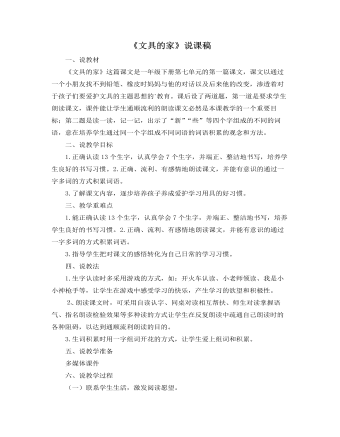
部编人教版一年级下册《文具的家》说课稿
一、说教材《文具的家》这篇课文是一年级下册第七单元的第一篇课文,课文以通过一个小朋友找不到铅笔、橡皮时妈妈与他的对话以及后来他的改变,渗透着对于孩子们要爱护文具的主题思想的`教育。课后设了两道题,第一道是要求学生朗读课文,课件能让学生通顺流利的朗读课文必然是本课教学的一个重要目标;第二题是读一读,记一记,出示了“新”“些”等四个字组成的不同的词语,意在培养学生通过同一个字组成不同词语的词语积累的观念和方法。二、说教学目标1.正确认读13个生字,认真学会7个生字,并端正、整洁地书写,培养学生良好的书写习惯。2.正确、流利、有感情地朗读课文,并能有意识的通过一字多词的方式积累词语。3.了解课文内容,逐步培养孩子养成爱护学习用具的好习惯。
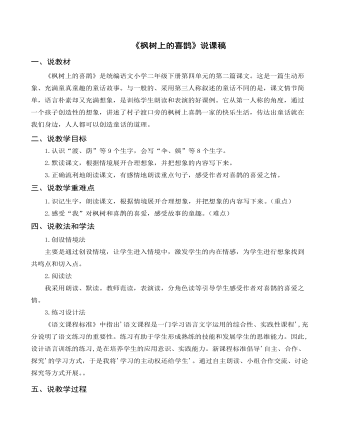
(说课稿)《枫树上的喜鹊》部编人教版二年级上册语文
二、说教学目标1.认识“渡、荫”等9个生字,会写“伞、姨”等8个生字。 2.默读课文,根据情境展开合理想象,并把想象的内容写下来。? 3.正确流利地朗读课文,有感情地朗读重点句子,感受作者对喜鹊的喜爱之情。三、说教学重难点1.识记生字,朗读课文,根据情境展开合理想象,并把想象的内容写下来。(重点) 2.感受“我”对枫树和喜鹊的喜爱,感受故事的童趣。(难点)四、说教法和学法1.创设情境法主要是通过创设情境,让学生进入情境中,激发学生的内在情感,为学生进行想象找到共鸣点和切入点。? 2.阅读法我采用朗读、默读。教师范读,表演读,分角色读等引导学生感受作者对喜鹊的喜爱之情。3.练习设计法《语文课程标准》中指出'语文课程是一门学习语言文字运用的综合性、实践性课程',充分说明了语文练习的重要性。练习有助于学生形成熟练的技能和发展学生的思维能力。因此,设计语言训练的练习,是在培养学生的应用意识、实践能力。新课程标准倡导'自主、合作、探究'的学习方式,于是我将'学习的主动权还给学生'。通过自主朗读、小组合作交流、讨论探究等方式开展。
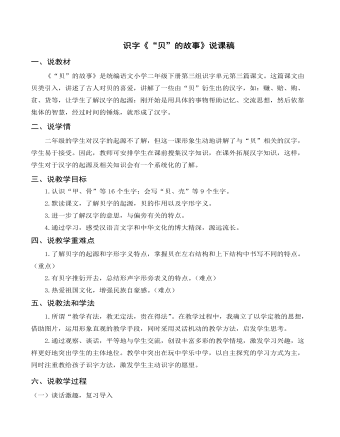
(说课稿)识字《 “贝”的故事》部编人教版二年级上册语文
一、说教材《“贝”的故事》是统编语文小学二年级下册第三组识字单元第三篇课文。这篇课文由贝类引入,讲述了古人对贝的喜爱,讲解了一些由“贝”衍生出的汉字,如:赚、赔、购、贫、货等,让学生了解汉字的起源:刚开始是用具体的事物帮助记忆、交流思想,然后依靠集体的智慧,经过时间的锤炼,就形成了汉字。二、说学情二年级的学生对汉字的起源不了解,但这一课形象生动地讲解了与“贝”相关的汉字,学生易于接受。因此,教师可安排学生在课前搜集汉字知识,在课外拓展汉字知识,这样,学生对于汉字的起源及相关知识会有一个系统化的了解。三、说教学目标1.认识“甲、骨”等16个生字;会写“贝、壳”等9个生字。2.默读课文,了解贝字的起源,贝的作用以及字形字义。3.进一步了解汉字的意思,与偏旁有关的特点。4.通过学习,感受汉语言文字和中华文化的博大精深,源远流长。
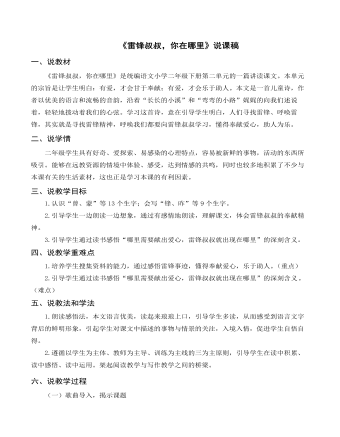
(说课稿)《雷锋叔叔,你在哪里》部编人教版二年级上册语文
三、说教学目标1.认识“曾、蒙”等13个生字;会写“锋、昨”等9个生字。2.引导学生一边朗读一边想象,通过有感情地朗读,理解课文,体会雷锋叔叔的奉献精神。3.引导学生通过读书感悟“哪里需要献出爱心,雷锋叔叔就出现在哪里”的深刻含义。四、说教学重难点 1.培养学生搜集资料的能力,通过感悟雷锋事迹,懂得奉献爱心,乐于助人。(重点)2.引导学生通过读书感悟“哪里需要献出爱心,雷锋叔叔就出现在哪里”的深刻含义。(难点)五、说教法和学法1.朗读感悟法,本文语言优美,读起来琅琅上口,引导学生多读,从而感受到语言文字背后的鲜明形象,引起学生对课文中描述的事物与情景的关注,入境入情,促进学生自悟自得。2.遵循以学生为主体、教师为主导、训练为主线的三为主原则,引导学生在读中积累、读中感悟、读中运用。架起阅读教学与写作教学之间的桥梁。

(说课稿)《沙滩上的童话》部编人教版二年级上册语文
一、说教材《沙滩上的童话》是统编语文小学二年级下册第四单元的一篇课文。这是一个非常感人的故事,课文比较具有童趣,与孩子的生活相贴近,符合孩子的年龄特点。 作者用诗一般的语言讲述了一群孩子在沙滩上垒起一座城堡,然后展开想象的翅膀编织了一个美丽的童话:城堡里住着一个凶恶的魔王,抢走了美丽的公主……最后,这群孩子成为攻打城堡的勇士,他们炸死了魔王,救出了公主。故事一方面展现了孩子们快乐缤纷的童年生活,另一方面也歌颂了一种人间的善良温情与正义。在孩子们的童话中,那对生活的热爱之情,那纯真地对他人的关爱和帮助,尽显人性之美。二、说学情二年级下学期,学生已经具备了一定的学习字词的能力和自主阅读的能力。这篇课文的词语比较浅显,可以让学生在阅读中自己积累。对于生字的教学,我重点讲述容易混淆的生字,同时,这样也可以从现在开始培养学生养成良好的预习及阅读习惯。 但学生由于年龄小,注意力不够集中,所以更喜欢情节性较强的故事,需要教师引导在故事中体验情感。
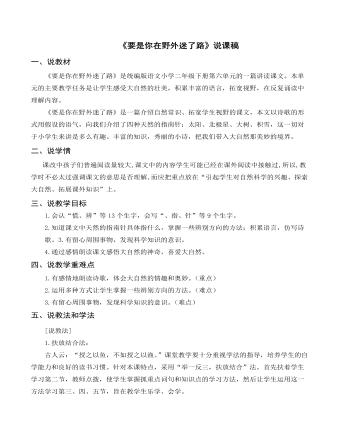
(说课稿)《要是你在野外迷了路》部编人教版二年级上册语文
六、说教学过程(一)创设情境,激趣导入 一堂课的开始,为了使学生尽快地进入学习状态,在情境创设中,应该做到新颖,要让学生感受到一种新的情境,从而产生好奇心,达到集中注意力的目的。教学开始,我首先创设情境,提出了两个问题:1.如果你在大街上迷路了,你会怎么做?2.如果你在野外迷了路,你又会怎么做?【设计意图】这两个问题的提出让学生区分在不同的地点迷了路要用不同的方法。然后我顺势导入课文:我们来学习课文,看看如果在野外迷了路,有什么办法分辨方向。(二)初读课文,整体感知 1.让学生自由读课文,要求把字音读准,把句子读通顺。然后老师范读一遍,让学生注意听老师是怎么读的,如字音、节奏等。2.再次自由读课文,按着老师的方法读诗歌,然后把本课的生字读一遍。【设计意图】这样,学生对于课文的生字和大概内容就有了一个整体印象,培养了他们的自学能力。
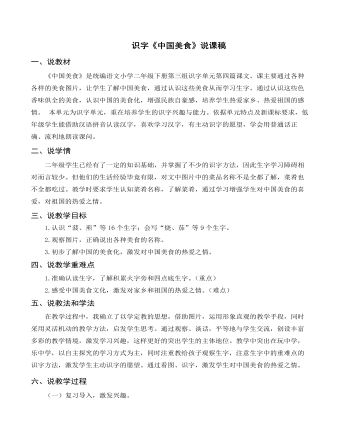
(说课稿)识字《中国美食》部编人教版二年级上册语文
一、说教材《中国美食》是统编语文小学二年级下册第三组识字单元第四篇课文。课主要通过各种各样的美食图片,让学生了解中国美食,通过认识这些美食从而学习生字。通过认识这些色香味俱全的美食,认识中国的美食化,增强民族自豪感,培养学生热爱家乡、热爱祖国的感情。 本单元为识字单元,重在培养学生的识字兴趣与能力。依据单元特点及新课标要求,低年级学生能借助汉语拼音认读汉字,喜欢学习汉字,有主动识字的愿望,学会用普通话正确、流利地朗读课问。二、说学情二年级学生已经有了一定的知识基础,并掌握了不少的识字方法,因此生字学习障碍相对而言较少。但他们的生活经验毕竟有限,对文中图片中的菜品名称不是全都了解,菜肴也不全都吃过。教学时要求学生认知菜肴名称,了解菜肴,通过学习增强学生对中国美食的喜爱,对祖国的热爱之情。
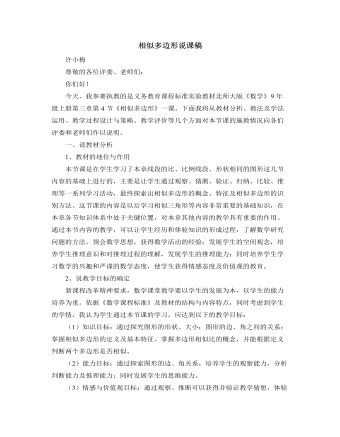
北师大版初中数学九年级上册相似多边形说课稿
五、说课件设计及板书随着教育现代化的发展,多媒体课件在课堂中辅助教师授课,帮助学生练习,已成为非常重要的教学辅助工具之一。在本节课的授课过程中,本人也使用了多媒体教学课件。课件在设计上遵循实用性原则、辅助性原则、创新性原则,紧紧围绕教学目标,服务于课堂教学,设计科学合理,制作精美细致;课件的有效使用很好地优化了课堂,极大地扩充了容量,有力地突出了重点,轻松地化解了难点;使学生学习兴趣浓郁,使教学效率大大提高;特别是在演示多边形对应角相等的设计,使这一教学环节变得更直观、更高效、更方便,让学生轻松地进行探究,很好地保护了学生的学习热情,方便了教师的策略实现。在授课过程中,我又不是完全依赖于多媒体课件,而成了课件反映员;我充分发挥教师的主导作用,合理地利用黑板板书有关内容,灵活动配合多媒体课件为学生呈现有关知识点,以弥补课件的不足。





















